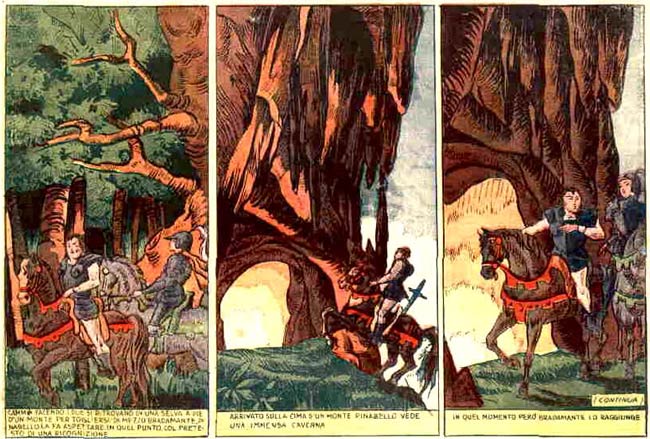'Topolino e il Mostro di Loch-Ness'.
Giovanni Bissietta was the pen name of the Italian painter, illustrator and art teacher Giuseppe F. Fontanelli. During the 1930s, he made several collectable figurine cards. These were typically illustrated stories in text comics format, with the text beneath the images. They included illegal 'Mickey Mouse' narratives, which were among the first Italian comics based on the famous mouse.
Early life and career
Giovanni Bissietta was born in 1910 in San Miniato (Pisa) and showed an early talent for drawing. He studied at the Royal Conservatory of Santa Chiara in San Miniato, and graduated at the Academy of Brera in Milan. He began his career working as a poster artist and illustrator, instantly signing his work with Bissietta. He made cartoons and comic strips for the magazines Cartoccino dei Piccoli, Robinson and L'Audace, and a couple of French publishing houses. One of his creations was the character 'Nottolino', which appeared in the children's tabloid Jumbo. For Robinson, he made an adaptation of the Italian epic poem 'Orlando Furioso'.
'Orlando Furioso'.
Figurines
Bissietta's best-known work from this period are the sets of so-called "figurines", which he made for publishers like Marca Stella. These were sets of illustrated cards with texts in rhyme, which depicted a story when complete. One of Bissietta's early sets was an adaptation in 27 figurines of Carlo Collodi's 'Pinocchio' story in 1929-1930. Among Bissietta's other series of "figurines" during the 1930s are 'Quando Il Gallo Canterà' (8 figurines), 'La Gola Castigata' (7 figurines) and 'Questa Non La Sapevi...' (probably 5 figurines).
Mickey Mouse
Bissietta's 27-figurine set 'Topolino e il Mostro di Loch-Ness' from around 1930 was the first locally produced comic strip in Italy starring Walt Disney's 'Mickey Mouse' ('Topolino'). Just like the work of Buriko and Guasta, Bissietta's work with Disney characters occurred without approval or consent of neither Disney, nor King Features Syndicate, who owned the rights to the 'Mickey Mouse' strip at the time. Official Italian licensing of Disney material only began in 1936, when Federico Pedrocchi drew his first 'Paperino' stories.
World War II and late 1940s
Bissietta was a member of the Milanese Artistic Family, and held his first solo exhibition in 1935. While in the army during World War II, he served as a war correspondent for the General Staff in Africa. He participated in an exposition of murals by army artists at the Palazzo delle Esposizioni in Rome. Bissietta subsequently became a correspondent for the Giornale dell'Arte. One of his notable works from this period were 'Fiori di Ghibli' (1944), a collection of sayings and thoughts written during the war in Africa. He also released a set of illustrated lyrics, called 'Orme' (1946). Both were published in book format by Gastaldi. Bissietta designed the costumes and the masks for the first national performance of T.S. Eliot's 'Murder in the Cathedral', under direction of Giorgio Strehler. Expositions of his work were held in Switzerland, Austria and Belgium.
Move to Australia
Bissietta emigrated to Australia in 1949. During the trip, he kept an illustrated diary for the Piacenza newspaper La Libertà. He stayed in Australia for twenty years, and served as the director of an Italian Art School, as a teacher at the National Art School of Sydney, as artistic director of the Summer School of the University of Adelaide, and as the representative-correspondent for University for Foreigners of Perugia. Bissietta organized annual exhibitions with work by his art students from 1951 onwards. In 1950, he made a large mural for the New Australian Centre in Elizabeth Street in Sydney, depicting the emigration of New Australians from Europe. He opened his Bissietta Art Gallery in Pitt Street, Sydney in July 1954, where he exhibited the work of prominent international authors.
Recognition
In 1948, Bissietta was honored with the title of member of the Academy of Euteleti of San Miniato. In 1962, he received a silver medal from the Italian government for the dissemination of Italian culture in Australia.
Final years and death
Bissietta returned to Italy in 1970. In 1971, he organized his first retrospective exhibition after returning home in the International Art Gallery of Florence. He taught art history at the university for Foreigners of Perugia and coordinated the international summer courses at the Academy of Fine Arts in Perugia. He founded an International Art Academy in San Miniato, which organized summer courses in fine arts and Italian art history. He passed away in Sant'Ilario d'Enza in 1977.








